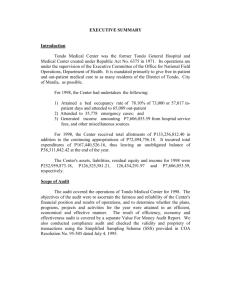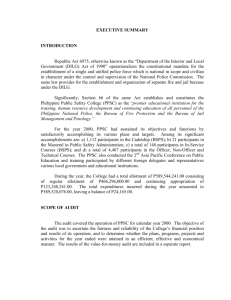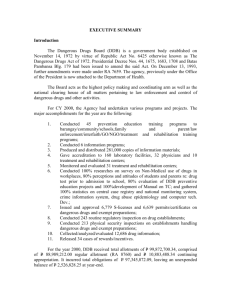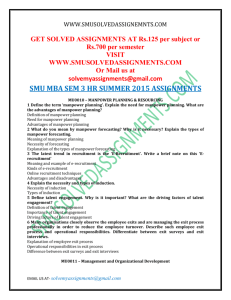EXECUTIVE SUMMARY INTRODUCTION The Construction
advertisement
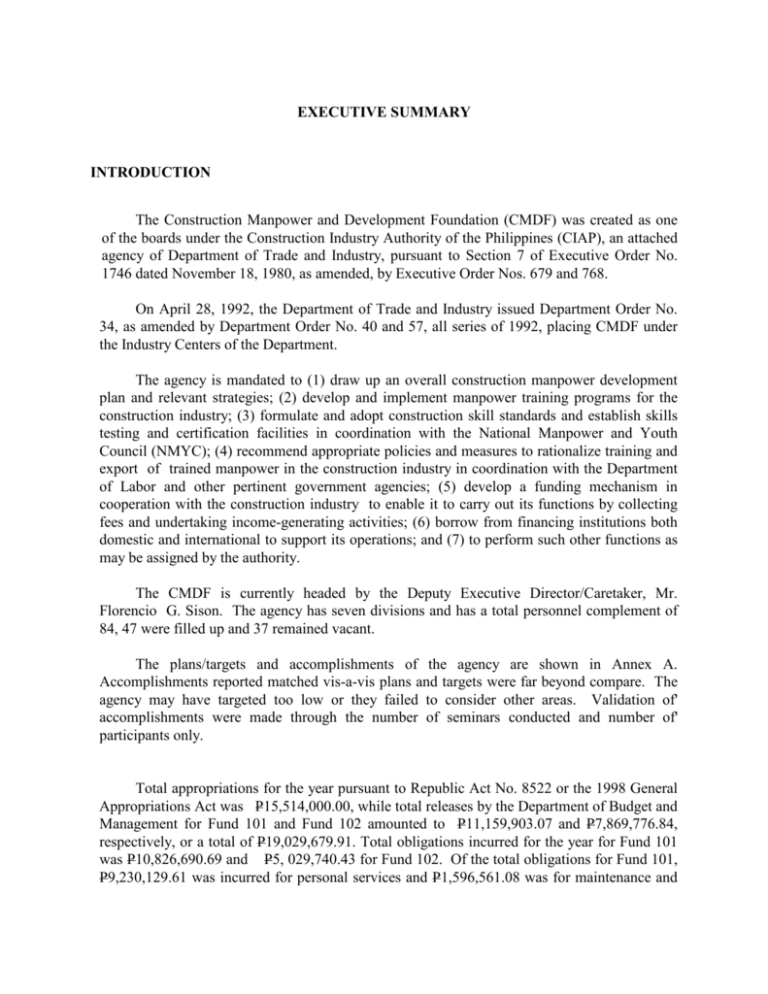
EXECUTIVE SUMMARY INTRODUCTION The Construction Manpower and Development Foundation (CMDF) was created as one of the boards under the Construction Industry Authority of the Philippines (CIAP), an attached agency of Department of Trade and Industry, pursuant to Section 7 of Executive Order No. 1746 dated November 18, 1980, as amended, by Executive Order Nos. 679 and 768. On April 28, 1992, the Department of Trade and Industry issued Department Order No. 34, as amended by Department Order No. 40 and 57, all series of 1992, placing CMDF under the Industry Centers of the Department. The agency is mandated to (1) draw up an overall construction manpower development plan and relevant strategies; (2) develop and implement manpower training programs for the construction industry; (3) formulate and adopt construction skill standards and establish skills testing and certification facilities in coordination with the National Manpower and Youth Council (NMYC); (4) recommend appropriate policies and measures to rationalize training and export of trained manpower in the construction industry in coordination with the Department of Labor and other pertinent government agencies; (5) develop a funding mechanism in cooperation with the construction industry to enable it to carry out its functions by collecting fees and undertaking income-generating activities; (6) borrow from financing institutions both domestic and international to support its operations; and (7) to perform such other functions as may be assigned by the authority. The CMDF is currently headed by the Deputy Executive Director/Caretaker, Mr. Florencio G. Sison. The agency has seven divisions and has a total personnel complement of 84, 47 were filled up and 37 remained vacant. The plans/targets and accomplishments of the agency are shown in Annex A. Accomplishments reported matched vis-a-vis plans and targets were far beyond compare. The agency may have targeted too low or they failed to consider other areas. Validation of' accomplishments were made through the number of seminars conducted and number of' participants only. Total appropriations for the year pursuant to Republic Act No. 8522 or the 1998 General Appropriations Act was P15,514,000.00, while total releases by the Department of Budget and Management for Fund 101 and Fund 102 amounted to P11,159,903.07 and P7,869,776.84, respectively, or a total of P19,029,679.91. Total obligations incurred for the year for Fund 101 was P10,826,690.69 and P5, 029,740.43 for Fund 102. Of the total obligations for Fund 101, P9,230,129.61 was incurred for personal services and P1,596,561.08 was for maintenance and other operating expenses. Total obligations of Fund 102 was incurred for maintenance and other operating expenses. Total trust receipts for the year amounted to P3,229,430.33. Total assets, liabilities and equity as of December 31, 1998, for Fund 101 were P13,124,195.84, P13,413,173.83 and ( P288,979.99), respectively while total assets, liabilities and equity for Fund 102 were P101,845,232.92, P12,808,731.70 and P89,036,696.62, respectively. SCOPE OF AUDIT The audit covered the operations of the Construction Manpower Development Foundation for 1998. The objectives of the audit were to ascertain the validity and propriety of disbursements, the reliability of financial reports and the adequacy of the books of accounts. Likewise, observation of day to day activities, ocular inspection coupled with verbal interviews of officials and employees were also conducted to determine whether the programs and activities for the year were attained in an efficient, economical and effective manner. However, validation of the agency's reported accomplishments was only based on the number of seminars conducted and the number of training participants. OPINION IN THE STATE AUDITOR'S REPORT ON THE FINANCIAL STATEMENTS The Auditor rendered a qualified opinion on the fairness of the presentation of the financial statements due to several deficiencies noted such as the doubtful balances of the fixed assets, furniture, fixtures and equipment and supplies and materials accounts totaling P97,342,136.97 due to the non-submission of inventory reports, and the non-liquidation of prior years cash advances amounting to P1, 170,071.75 which resulted to the overstatement of cash account SUMMARY OF SIGNIFICANT FINDINGS AND RECOMMENDATIONS For the exceptions cited in the preceding paragraph, the Auditor recommended the submission of inventory reports for fixed assets and supplies and materials accounts and the immediate liquidation of cash advances. In addition, the following are the other significant findings and recommendations: 1 . Cash in bank balances representing collection of seminar fees from 1996 to 1998 totaling P14,031,241.77 remained unremitted to the National Treasury contrary to Executive Order No. 338 dated May 17, 1996, and Joint Circular No. 1-97 dated January 2, 1997 Require the agency to comply with the provision cited in Executive Order No. 338 and Joint Circular No. 1-97. 2. Rates of seminar fees were neither standard nor approved by the Department of Budget and Management. Subsequently, quarterly reports for the receipts and disbursements of the seminars conducted were not submitted. Prepare standard rates for each type of seminar and seek approval from DBM. Also, prepare and submit the required quarterly report pertaining to the receipts and disbursements of the seminars conducted. 3. Handbooks for sale prepared by the agency and funded by Japan International Cooperation Agency (JICA) were not properly safeguarded and accounted. Likewise, no accounting was made for the proceeds of the handbooks sold out and the same were not deposited at the National Treasury. Secure from JICA written document as basis for accounting the books. Designate an accountable officer and require him/her to submit the required reports. Moreover, institute sound internal control in handling government properties. 4. The contract entered into by and between the CMDF represented by Ms. Alicia A. Tiongson, then Officer-in-Charge of CMDF, and Polytechnic University of the Philippines, represented by Dr. Zenaida A. Olonan, then PUP President, was not in accordance with Section 85, P. D. 1445. The aforementioned contract was entered without the corresponding appropriation. Define clearly the objective of the program/project. If the objective is already clear, include the project in the agency's lined activities and proposed a budget for the said activity. Regarding the existing contract, communicate the deficiency to the contracting parties citing the provisions of Section 87, of P.D. 1445. Also, avoid paying trust funds for those expenses, which are not related to training activities. 5. Bank Reconciliation Statements for Account Nos. 265-840148-6, 52-1244-09, 0052-107318 and 0142-0237-92 were not submitted to the Office of the Auditor contrarv to Section 147 of the National Accounting and Auditing Manual. Require the Accounting Official to prepare and submit the Bank Reconciliation Statements for each account monthly. 6. The agency's Supply Officer is not bonded contrary to Section 1O1, P.D. 1445 and Section 66 of the Government Accounting and Auditing Manual (GAAM Vol. 1). Require the bonding of Accountable Official pursuant to Section 101 of P.D. 1445 and the proper delegation of authority, duties and responsibilities to officials and employees must be enforced. 7. Audit suspensions which matured into disallowance amounted to P3,208,170.78 of which settlement was P1,202,640.48 or 37.48 percent while audit disallowances of P651,304.72 remained unsettled. Enforce settlement of the suspensions/disallowances pursuant to COA Manual on Certificate of Settlement and Balances The above, together with the other findings and recommendations contained in the report were discussed with concerned agency officials. Management views and reactions were considered in the report, where appropriate. STATUS OF IMPLEMENTATION BY THE AUDITEE OF PRIOR YEARS' AUDIT RECOMMENDATIONS There were 15 prior years' audit recommendations. One or 7 percent was fully implemented, while eight or 53 percent were partially implemented and six or 40 percent were not implemented. Two prior year's audit recommendations, which were not implemented, were reiterated and included under Part II of this report.
